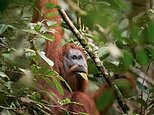World’s most threatened ape Tapanuli orangutan at greater risk of extinction
World’s most threatened ape at risk of extinction: Tapanuli orangutan is struggling to survive after being driven into the mountains by hunters and deforestation
- The Tapanuli orangutan lives in a small remote area of the Sumatra forests
- They were pushed into that region by deforestation and human hunters
- Researchers say they were once much more widespread and in lowland areas
The world’s most threatened ape, the Tapanuli orangutan, is in greater danger of becoming extinct than previously thought due to deforestation, study finds.
The rare primate species was only identified in 2017, with a small population of around 800 individuals living in the forests of North Sumatra in Indonesia.
Researchers now believe that their current habitat, which is restricted to mountain territory only, is not ideal for the creatures who live in disconnected groups.


A male Tapanuli orangutan (Andrew Walmsley)
The Tapanuli orangutan, scientific name Pongo tapanuliensis, currently occupies an area of about 1,000 square kilometres (386 sq miles) of upland forest.
This is only 2.5 per cent of the 40,796sq km (15,751 sq miles) range these great apes occupied 130 years ago, according to the researchers.
Professor Erik Meijaard, of the Durrell Institute of Conservation and Ecology, University of Kent, said previously scientists claimed these creatures were adapted to live in high elevations as they currently survive at 834 miles above sea level.
‘Our study, however, indicates that the Tapanuli used to primarily inhabit in lowland forest areas, and that a combination of unsustainable hunting and forest fragmentation drove the species to extinction in those areas.’
The team calculated the historic distribution range of the orangutan species by looking at records from journal and newspaper archives.
Documentation unearthed by the researchers revealed that large parts of the forests in northern Sumatra had already been converted to smallholder agriculture in the 1930s, long before industrial-scale plantation developments began in the 1970s.
The researchers believe that a combination of deforestation and unsustainable hunting practices ‘likely drove various populations to the south, east and west of the current population to extinction’.
Serge Wich, professor in primate biology at Liverpool John Moores University, said: ‘The apes are in more trouble than we previously thought.


The Tapanuli orangutan, scientific name Pongo tapanuliensis, currently occupies an area of about 1,000 square kilometres (386 sq miles) of upland forest


Researchers now believe that their current habitat, which is restricted to mountain territory only, is not ideal for the creatures who live in disconnected groups
Wich said there were two important findings from their research into the previous distribution and homes of the orangutan species.
‘First, the Tapanuli orangutan only retains a tiny part of its former range, where it likely became extinct because of a combination of unsustainable hunting and habitat fragmentation, and both these threats still affect the remaining populations.
‘And second, the Tapanuli is not specifically adapted to highland conditions, and should occur in a full range of habitats such as peat-swamp and lowland-dryland forests for optimal likelihood of survival in the wild,’ said Wich.
‘The fact that this species has likely been driven to extinction in the peat-swamp forests of North Sumatra is therefore a major concern,’ the researcher added.
The research is published in the journal Plos One.
![]()


